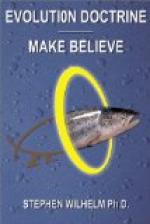A brief survey of the varied groups of animals themselves is sufficient to bring to light many biological reasons which account for still more of the vacant spaces in the palaeontological record. We would hardly expect to find remains of ancient microscopic animals like the protozoa, unless they possessed shells or other skeletal structures which in their aggregate might form masses like the chalk beds of Europe. Jellyfish and worms and naked mollusks are examples of the numerous orders of lower animals having no hard parts to be preserved, and so all or nearly all of the extinct species belonging to these groups can never be known. But when an animal like a clam dies its shell can resist the disintegrating effects of bacteria and other organic and inorganic agencies which destroy the soft parts, and when a form like a lobster or a crab, possessing a body protected by closely joined shell segments, falls to the bottom of the sea, the chances are that much of the animal’s skeleton will be preserved. Thus it is that corals, crustacea, insects, mollusks, and a few other kinds of lower forms constitute the greater mass of invertebrate palaeontological materials because of their supporting structures of one kind or another. Perhaps the skeletal remains of the vertebrates of the past provide the student of fossils with his best facts, on account of the resistant nature of the bones themselves, and because the backboned animals are relatively modern; then, too, the rocks in which their remains occur have not been so much altered by geological agencies, or buried so deeply under the strata formed later. Of course only the hardest kinds of shells would remain as such after their burial in materials destined to turn into rock; in the majority of cases, an entombed bone is infiltrated or replaced by various mineral substances so that in time little or nothing of the original thing would remain, though a mold or a cast would persist.




